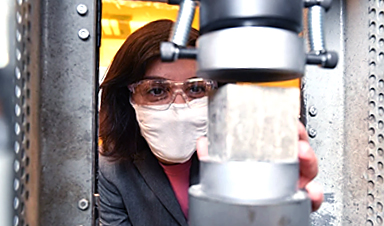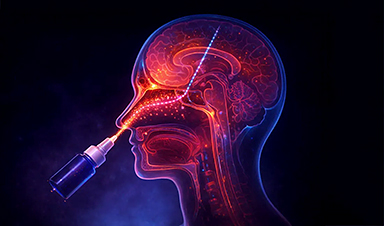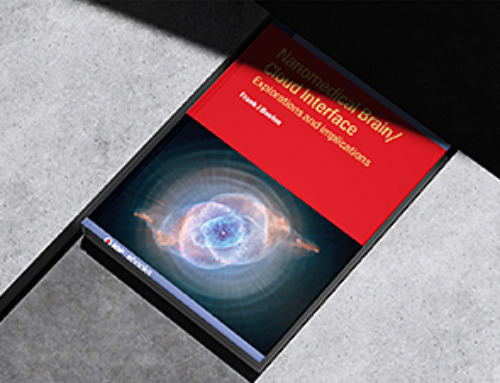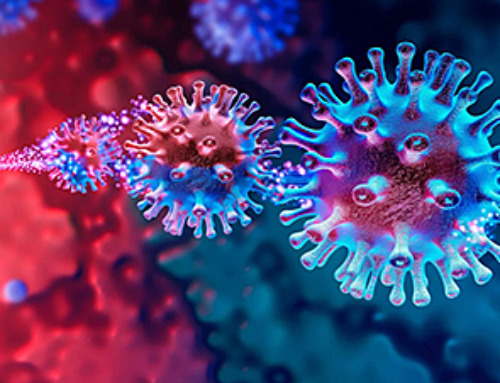When shrimp shell nanoparticles were mixed into cement paste, the material became substantially stronger — researchers propose an innovation that could lead to less seafood waste and fewer carbon dioxide emissions from concrete production.
A team of Washington State University and Pacific Northwest National Laboratory scientists created nanocrystals and nanofibers of chitin, the second-most common biopolymer in nature, from waste shrimp shells, as reported in the journal Cement and Concrete Composites.
When such small chitin bits, about 1,000 times tinier than a human hair, were mixed into cement paste, the resulting product was up to 40% stronger. The hardening time of the cement was also prolonged by more than an hour, which is a desirable property for lengthy transport and hot weather concrete work.
The concrete industry is under pressure to reduce its carbon emissions from the production of cement. By developing these novel admixtures that enhance the strength of concrete, we can help reduce the amount of required cement and lower the carbon emissions of concrete.
Somayeh Nassiri, Associate Professor, University of California
Nassiri headed the research at WSU.
Concrete is used in vital infrastructure like buildings, bridges, and roads all over the world. It is the second most used material on the planet after water. Cement production is a carbon-intensive process that necessitates the use of fossil fuels to achieve the needed high temperatures (1500 °C).
The limestone used in its manufacturing also decomposes, releasing additional carbon dioxide. Cement production accounts for about 15% of industrial energy consumption and 5% of global emissions of greenhouse gases.
According to Nassiri, the issue of durability primarily motivates the high consumption of the material—concrete cracks quickly and must be replaced or repaired frequently.
In the meantime, seafood waste is a major issue for the fishing industry, which produces between 6 million and 8 million pounds of waste per year globally. According to Hui Li, research assistant professor in WSU’s Composite Materials and Engineering Center and corresponding author on the paper, the majority of that waste is thrown into the sea.
In the current world, dealing with climate change through the circular economy, we want to use waste materials as much as possible. One person’s waste is another person’s treasure.
Somayeh Nassiri, Associate Professor, University of California
Scientists have worked to enhance concrete using cellulose, a common biopolymer. Cellulose additives would sometimes help the concrete and sometimes not, and the scientists could not figure out why this was.
The WSU team investigated chitin materials at the nanoscale in their research. Crab, shrimp, and lobster shells contain about 20-30% chitin, with the remaining being calcium carbonate, another useful additive for cement. In comparison to cellulose, chitin has an extra set of atoms—a functional group—that enables the scientists to regulate the charge on the surface of the molecules and, thus, how they act in the cement slurry.
“Being able to control the charge on the surface is an important piece to controlling how they function in cement. We could do that quite simply on the chitin because of the carboxyl group that sits in the chitin polymer,” said WSU Regents Professor Michael Wolcott, a corresponding author of the paper.
The success of the cement paste hardening came down to how the particles suspended themselves within the cement slurry and interacted with the cement particles.
“The chitin nanoparticles repel individual cement particles enough so that it changes the hydration properties of the cement particle within the system,” he said.
They were able to enhance and target the cement’s properties, such as its uniformity, setting time, resilience, and sturdiness, by adding processed nanocrystals of chitin to it. They discovered a 40% rise in the strength of the concrete’s bending capacity and a 12% increase in its ability to compress.
“Those are very significant numbers. If you can reduce the amount that you use and get the same mechanical function or structural function and double its lifetime, then you’re able to significantly reduce the carbon emissions of the built environment,” Wolcott said.
The scientists are now expecting to scale up their work so that they can produce the additive on a large scale. The study must also continue to achieve the same degree of improvement seen on the cement paste scale on the concrete scale.
Aside from the WSU researchers, the interdisciplinary team included Pacific Northwest National Laboratory scientists. The research was supported by the Department of Energy’s Advanced Research Projects Agency-Energy (ARPA E) program, which funds innovative and unconventional energy technology projects that have the potential to lead to emerging technologies.
News
Global Health Care Equivalency in the Age of Nanotechnology, Nanomedicine and Artificial Intelligence
A new book by Frank Boehm, NanoappsMedical Inc. Founder. This groundbreaking volume explores the vision of a Global Health Care Equivalency (GHCE) system powered by artificial intelligence and quantum computing technologies, operating on secure [...]
New Book! NanoMedical Brain/Cloud Interface – Explorations and Implications
New book from Frank Boehm, NanoappsMedical Inc Founder: This book explores the future hypothetical possibility that the cerebral cortex of the human brain might be seamlessly, safely, and securely connected with the Cloud via [...]
Miller School Researchers Pioneer Nanovanilloid-Based Brain Cooling for Traumatic Injury
A multidisciplinary team at the University of Miami Miller School of Medicine has developed a breakthrough nanodrug platform that may prove beneficial for rapid, targeted therapeutic hypothermia after traumatic brain injury (TBI). Their work, published in ACS [...]
COVID-19 still claims more than 100,000 US lives each year
Centers for Disease Control and Prevention researchers report national estimates of 43.6 million COVID-19-associated illnesses and 101,300 deaths in the US during October 2022 to September 2023, plus 33.0 million illnesses and 100,800 deaths [...]
Nanomedicine in 2026: Experts Predict the Year Ahead
Progress in nanomedicine is almost as fast as the science is small. Over the last year, we've seen an abundance of headlines covering medical R&D at the nanoscale: polymer-coated nanoparticles targeting ovarian cancer, Albumin recruiting nanoparticles for [...]
Lipid nanoparticles could unlock access for millions of autoimmune patients
Capstan Therapeutics scientists demonstrate that lipid nanoparticles can engineer CAR T cells within the body without laboratory cell manufacturing and ex vivo expansion. The method using targeted lipid nanoparticles (tLNPs) is designed to deliver [...]
The Brain’s Strange Way of Computing Could Explain Consciousness
Consciousness may emerge not from code, but from the way living brains physically compute. Discussions about consciousness often stall between two deeply rooted viewpoints. One is computational functionalism, which holds that cognition can be [...]
First breathing ‘lung-on-chip’ developed using genetically identical cells
Researchers at the Francis Crick Institute and AlveoliX have developed the first human lung-on-chip model using stem cells taken from only one person. These chips simulate breathing motions and lung disease in an individual, [...]
Cell Membranes May Act Like Tiny Power Generators
Living cells may generate electricity through the natural motion of their membranes. These fast electrical signals could play a role in how cells communicate and sense their surroundings. Scientists have proposed a new theoretical [...]
This Viral RNA Structure Could Lead to a Universal Antiviral Drug
Researchers identify a shared RNA-protein interaction that could lead to broad-spectrum antiviral treatments for enteroviruses. A new study from the University of Maryland, Baltimore County (UMBC), published in Nature Communications, explains how enteroviruses begin reproducing [...]
New study suggests a way to rejuvenate the immune system
Stimulating the liver to produce some of the signals of the thymus can reverse age-related declines in T-cell populations and enhance response to vaccination. As people age, their immune system function declines. T cell [...]
Nerve Damage Can Disrupt Immunity Across the Entire Body
A single nerve injury can quietly reshape the immune system across the entire body. Preclinical research from McGill University suggests that nerve injuries may lead to long-lasting changes in the immune system, and these [...]
Fake Science Is Growing Faster Than Legitimate Research, New Study Warns
New research reveals organized networks linking paper mills, intermediaries, and compromised academic journals Organized scientific fraud is becoming increasingly common, ranging from fabricated research to the buying and selling of authorship and citations, according [...]
Scientists Unlock a New Way to Hear the Brain’s Hidden Language
Scientists can finally hear the brain’s quietest messages—unlocking the hidden code behind how neurons think, decide, and remember. Scientists have created a new protein that can capture the incoming chemical signals received by brain [...]
Does being infected or vaccinated first influence COVID-19 immunity?
A new study analyzing the immune response to COVID-19 in a Catalan cohort of health workers sheds light on an important question: does it matter whether a person was first infected or first vaccinated? [...]
We May Never Know if AI Is Conscious, Says Cambridge Philosopher
As claims about conscious AI grow louder, a Cambridge philosopher argues that we lack the evidence to know whether machines can truly be conscious, let alone morally significant. A philosopher at the University of [...]





















